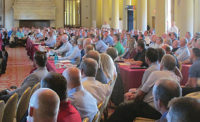For a second year in a row during AIM/R’s annual conference, Supply House Times sat down with a group of PHCP manufacturers representatives to get a pulse on the current landscape when it comes to the rep business.
This year’s group included Jon Wiggs of Wiggs-Haun & Bohan out of Nashville, Tennessee (2019 PM Engineer rep of the year winner), Charlie Parham, president and principal of Dallas, Texas-based Pepco Sales & Marketing (past Plumbing & Mechanical rep of the year recipient), Dean Parker, president at St. Paul, Minnesota-based Michel Sales Agency (past PM Engineer rep of the year winner), Dan Milroy, managing partner at Coquitlam, British Columbia-based Equipco Ltd., and Jeff Blair, president of Vancouver, British Columbia-based Barclay Sales Ltd.
Panelists wasted little time getting the discussion flowing during the hour-plus-long exclusive session, first by talking about how the relationship has changed with manufacturers and how the rep-factory dynamic can continue to evolve.
“Whether it be the showroom, builder, mechanical, architect or designer, manufacturers need us to touch all channels,” Wiggs said. “On top of all the channels, we must maintain the customer service calls and training within all segments. While we are more than capable to handle all channels, there are costs involved with doing so. Adding additional employees comes at a real cost so you must invest in your business wisely.”
Michel Sales’ Parker added: “But through that there is an increase in trust on both sides. They trust us more, so therefore they give us more. In order to be efficient, you have to trust your manufacturer. One of the gentlemen inducted into the AIM/R Hall of Fame (during the conference) said reps in the beginning were considered coupon clippers. That doesn’t resonate at all today. We are a trusted partner and I think that has really strengthened across the channel. The rep has a bright future, but with a bright future comes more work to do.”
Wiggs replied: “We have become more than a sales company. We are adding all these extras. When people ask what you do, I say: “We are a sales and marketing firm. We do so much more than just sell.”
Blair made a suggestion that more manufacturers need to have rep councils. “Rep councils are one of the most underutilized tools a manufacturer has to get the most of out their reps,” he said. “We had a session here at the conference on how to run a great rep council and it was spot-on. It’s shocking how few manufacturers do it.”
Parker added: “But they have to be good rep councils. They have to be constructive. I have been on some that are more interested in getting together and playing golf. I prefer the ones with an itinerary — a living document where there’s movement of the ball every month or every six months going up to the meeting. We want solid content.”
This question morphed back to the manufacturer relationship and the touchy subject of commissions. “Commission rates don’t reflect all we do,” Wiggs said.
“It’s a big challenge,” Parham added. “The best rep agencies are out there doing more and that should be reflected in commissions. The best manufacturers are the ones that have year-end bonuses or that have commission rates that change based on what is important to that manufacturer. You are seeing a trend where manufacturers are using a tool where they say, ‘I’d rather have them sell more of product X, which is really important to us. Therefore, you will get paid more.”
Blair said relationships are about setting expectations. “The way the manufacturer-rep relationship will work best is by being really solid on setting the expectations,” he said. “It sounds basic, but it’s something that reps and manufacturers should be doing better, quite frankly.”
When talking about what they look for in a line, the word synergy was frequently used. “The synergistic line card and package will never go away,” Milroy said. “This is the backbone to what we do.”
Blair added: “It’s important to find a manufacturer that’s in the spaces you already are in. Is this a manufacturer that fits with residential new construction contractors? You have to get really specific when you are looking at the synergies of a potential new manufacturer.”
Parham said he takes into consideration the capabilities within his own company. “Let’s say a company approaches us with a really technical pump line,” he said. “I probably wouldn’t take it because it doesn’t fit the technical ability within our own company. On the other hand, we’ll take a look and see if a product blends with other things we have, such as fixtures, and determine if it would be a nice fit within a package.”
Within the channel, Wiggs said the relationship with the distributor remains critical. “They are our business partner,” he said.
Parham added: “We are an important and integral part of their business and helping them sell. They are bombarded with product and they need some assistance to target.”
Milroy said: “There was a time when distribution tried to cut the rep out of the equation so they could increase their rebate. That’s evolved now where they realize they do need reps.”
Parker labeled the rep-distributor relationship “better than it ever has been,” he said. “We write battle plans together and how we are going to take our lines to market. That wasn’t always the case, and it really speaks to how that relationship has evolved in a good way. We are a lot more tactical with distributors in a good way.”
The reps on the panel were asked if they were granted two wishes from an industry genie, what would they be.
“To have more quality people,” Milroy said. “One of the biggest challenges is to find people who can properly represent all the lines we manage and carry.”
Blair added: “I live in one of the most expensive cities in North America (Vancouver) and I had two employees come in last month saying they want to buy a home but can’t do it in the city. They didn’t want to leave our company. We set them up with a phone system and a computer where they live.
Everything they are doing in the office, they can do remotely. No one will know they aren’t here. That’s how we keep people. To keep good people, you have to go outside the box.”
Wiggs would like to see more manufacturers representatives and manufacturers investing in their companies through joining AIM/R. “There are many practices to be learned and shared to make our industry stronger for the benefit of all,” he said.
Parker’s wish is to see a common reporting process. “If everybody’s on Salesforce, great. If everyone is going to be on some Google paper form, awesome,” he said. “That’s part of being a rep, but we have to operate within all the different manufacturer processes and procedures. In this world where we are so close to technological solutions, having some similarities would be great.”
Like Wiggs, other rep panelists stressed the importance of being an AIM/R member. “By joining AIM/R you are saying you want to be a better company,” Parham said.
Parker added: “It’s paramount because of the networking opportunities and the knowledge you gain. When a manufacturer calls us up and asks if are you interested in interviewing, the first thing we do is we look at our AIM/R buddies and see if they represent that line and we will get a report from them first. AIM/R is a culture of excellence for rep leaders.”






